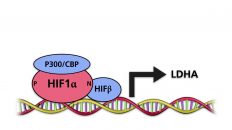Cells within growing tissues need a constant supply of oxygen. Under physiological conditions, the delivery of oxygen is well regulated; under pathological conditions, however, the availability of oxygen may be limited. For example, severe hypoxia may develop in rapidly growing tumors. In small tumors with a diameter of less than 1 mm, oxygen may be supplied by diffusion, thus the fraction of oxygen in small tumors corresponds to the fraction in normal tissues. When tumor growth continues, the oxygen levels drop in the tumor areas distant from blood vessels. When oxygen levels drop below 0.02%, tumor cells experience severe hypoxia and die. In the video, a stained section of a tumor is shown. The tumor contains vital tissue areas. However, in other areas of the tumor, the tissue became necrotic because of insufficient supply of oxygen and nutrients. In order to avoid the death of tumor cells, hypoxic tumors induce the sprouting of new blood vessels from existing blood vessels, a process called angiogenesis. In addition, tumor cells may invade the surrounding tissue in order to escape areas of low oxygen levels. When cells experience shortage of oxygen, they produce a family of transcription factors classified under the term Hypoxia-Induced Factor (HIF).
Onkoview 2015





